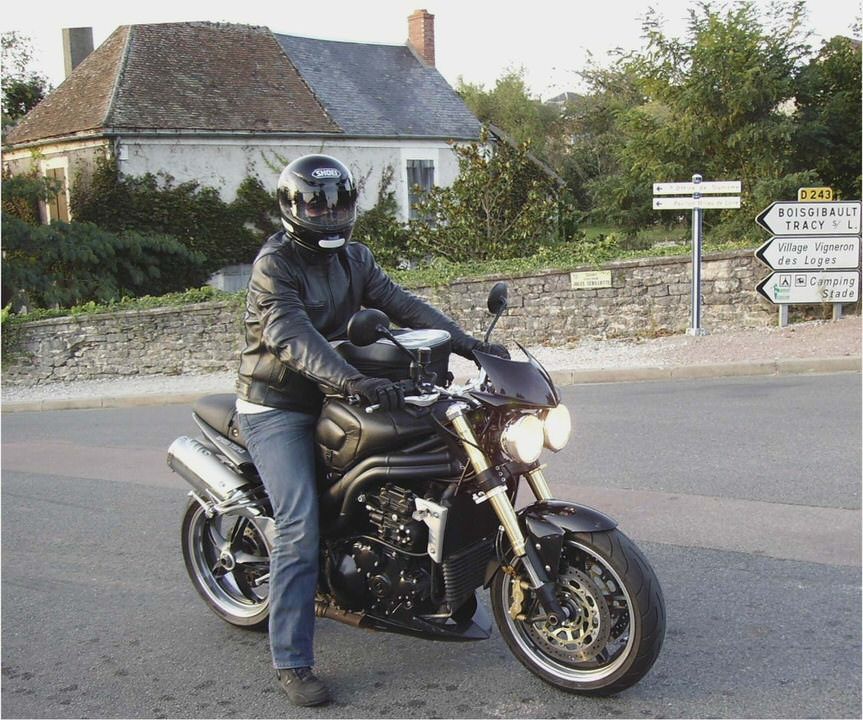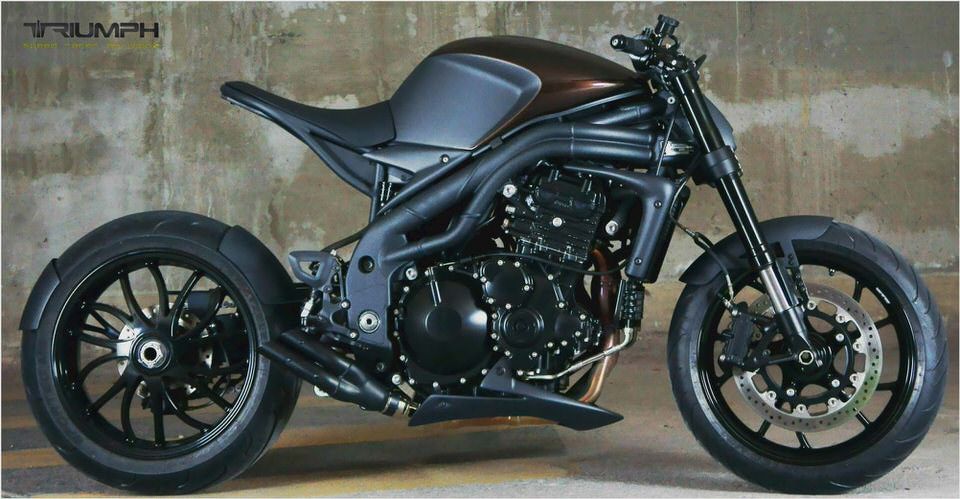
km. First Ride
2011 Triumph Speed Triple 1050 – Return of the King
John Acton
March 9 2011
It’s good to be the king. Or at least it would be if pretenders and contenders weren’t always trying to steal your spot at the top. First launched in 1995, the Triumph Speed Triple was the first of its kind: a sportbike, stripped of unnecessary fairings and clip-ons in favor of a wide handlebar and exposed mechanicals. Its starring role in the film Mission: Impossible 2 helped the Speed Triple become the king of the naked sportbikes.
With its bug-eyed twin headlamps and fuel-injected inline triple, it was like nothing anyone had seen before. It backed those looks up, too, borrowing engine, chassis, and suspension components from the award-winning Daytona 955 that was released the year before.
Through the last decade, the Triumph’s reign was besieged by opponents from not only Asia and Europe, but America as well. Buell’s 1125CR and the Yamaha FZ-1 certainly offered serious bang for the buck, and Ducati’s 1198 Superbike-based Streetfighter certainly has pedigree. Despite the assaults it always stood tall against the challengers, typically winning over both journalists and consumers by offering the best combination of usable performance and overall good looks.
The 2005 redesign, with 128 horsepower on tap from the bigger 1050 cc engine, made sure no one dared to go toe-to-toe with the King.
Ironically, it was a coup d’état that began in 2007 with the release of the Daytona 675-derived Street Triple that presented the biggest threat to the Speed Triple’s sovereignty. By mimicking the big Speed’s styling, the little Street’s power and ease-of-use gave buyers the choice between the two-wheeled equivalents of a muscle car and a sports car. In the end, lightweight and nimble won out over raw power and size.
Ultimately overshadowed by its “little brother” in magazines and on the sales floor, the Speed Triple once representing a full 10 percent of Triumph’s North American sales began to fade into the background. A mid-generation facelift in 2008 didn’t do much to steer buyers back to the big-bore 1050; the Speed Triple was just too long in the tooth.
It was deemed too heavy at 417 pounds compared to the Street’s 368-pound dry weight, too tall at 32.7 inches of seat height, and just too dated. The chrome twin round headlamps, while a traditional Triumph styling cue, didn’t fit with the modern styling and materials. Moreover, the frame was essentially the same as it had been since 1997, while the Street Triple’s chassis was derived from the significantly more modern design of the Daytona 675.
Refusing to allow the empire to fall, Triumph has given the king a much-needed makeover. On paper, the changes don’t appear very impressive. Still using a 1050cc engine that is essentially a stroked variant of the original ’97 Daytona’s 955-cc engine, the performance boost from 128 horsepower to 133 is only slightly less underwhelming than the claimed weight loss of just seven pounds.
Heck, that’s just barely heavier than a single gallon of gas. But what the spec sheet doesn’t say is how much lighter and faster the new Speed Triple feels. And at the end of the day, that’s where it counts.
Our day begins with a brisk ride through the Yavapai Nation in central Arizona. Mounting the new Triple, the changes are immediately evident. The seat height is just a tenth of an inch lower, but the slimmer profile where it meets the fuel tank makes it easier to reach the ground.
Turn the key to the right, and the new dashboard flickers and whirrs to life. Ostensibly the same revised cluster from the Daytona 675, the new Speed Triple’s instrument layout has been rearranged to maximize visibility where it’s needed most. The shift lights are brighter and more prominent but the Speed Triple also receives a fuel gauge and optional TPMS readout.
The system uses sensors inside the wheel rims which replace the standard valve stem assemblies, sending a real-time readout of tire pressure on both wheels that can be viewed at the touch of a button.
The fuel tank and air box are now separated front-to-back rather than the fuel cell sitting above the intakes. With the air runners now much closer to the rider, the unique howl of the three-cylinder engine is significantly more pronounced, and all the more spine-tingling as we rev the big Triple to its 10,000-rpm redline. And though we initially scoffed at the gain of just five horsepower, that combined with the additional six lb-ft of torque make this Triple the speediest of them all.
The gains are across almost the entire rev-range, making the new engine feel like the entire power and torque curves have simply been raised.
This new tank assembly sits atop an all-new tubular chassis that’s both lighter and narrower, allowing the big Triple to be ridden like a sportbike. Tucking down behind an imaginary windscreen is much easier than on previous models because of the less acute angle on the rear of the fuel cell. The seat has been elongated for comfort and is much further forward as well, allowing for a shorter reach to the handlebars.
Moving the liquid-cooled 1050-cc powerplant forward three millimeters and tilting it forward seven degrees helped improve the bike’s weight distribution from 48.6/51.4 to 50.9/49.1 front-to-rear. Given that the front wheel lost three pounds and the bike wears thinner front brake rotors, this more forward weight-bias is all the more necessary.
Steering geometry typically plays the biggest role in making a big bike feel little, and Triumph kept that in mind with the completely revised front end. Rake and trail have both been optimized by going from 23.5 degrees and 84 millimeters to 22.8 degrees and 91 millimeters, respectively, while new fully-adjustable 43-mm Showa forks are held in place with new forged aluminum (pronounced al-you-MIN-ee-um, Triumph will have you know) upper and lower triple clamps.
With those aggressive changes up front, stability and keeping the rear tire planted might have become a problem. So the 18.5-mm longer (yet two-pound lighter) swingarm helped make sure our lines were tight without compromising the quicker steering. We also love how the new Triple feels lighter despite the new, larger ten-spoke rear wheel wrapped in a wider 190-series tire.
We think the engineers in Hinckley must’ve been schooled at Hogwarts since all of these changes somehow made the big Triumph turn in and steer like a middleweight.

With the new front-end, every bump and turn through the sweeping twisties of Arizona’s desert roads feels easy. Though we’re not admitting to any hooligan activities (at least in writing) the front suspension and new rear shock with revised linkage allows either end of the bike to lift with ease, depending on how aggressively one applies the throttle or front brake. Unlike many modern streetfighters, the Speed Triple also has no electronic nanny to shut down the tire-smoking and wheelies.
And contrary to popular belief, we’ve learned that anti-lock brakes don’t prevent stoppies, either.
Fit and finish has always been a strong suit of Triumph, and the new Speed Triple resets the bar. The textured powdercoating on the hand-welded frame has a metallic flake to it. Our test bike was in a new pearlescent color called “Crystal White” that replaces the plain white color from previous model years while the few unpainted plastic trim pieces are made of a thick stock that Triumph claims will resist fading over the years.
Even the new aluminum sidestand and redesigned footpegs are Triumph-exclusive and of a higher quality than even the Italian superbikes. The Speed Triple is also the first Triumph to feature coded keys that tie to an immobilizer unit for security. All this can be yours for $11,799 or $12,599 with ABS.
Alas, a few things we’d really like to have seen on the bike are not an option. A gear indicator would’ve been nice, as it’s now standard on every new Triumph triple since 2006. Triumph tells us that because the 1050 engine cases are basically derivations of the original ’97 design, there is nowhere to mount the sensor.
Since the dash is based on the same hardware, we’d have loved to see the very cool new reverse-lit LCD display found on the 2011 Daytonas. We are also left wondering why there are two versions available—with and without ABS—when the ABS models have a selector switch.
Then, of course, there’s the styling. Obviously, the new Speed Triple had to retain some of its forefather’s DNA with the single-sided swingarm and unique lighting. Opting for a more contemporary look, the telltale twin headlamps have evolved into more angular modern units.
The new ten-spoke wheels are over four pounds slimmer for the pair, but look more delicately crafted than the beefy three-spokes from the earlier models. The dual high-mount mufflers also got re-shaped from ovals into trapezoids and lost 2.2 pounds in the process. Though it may seem that some of the styling changes were merely for the sake of change, we’re fans of the update.
Overall, the 2011 Speed Triple still looks like it should: two lights up front, single-arm out back, and a whole lot of engine in the middle. No one can argue against less weight, and more power means the new Triple performs like it should.
The Speed Triple rules once again. Attempted usurpers of its crown, namely the Ducati Streetfighter and newly redesigned MV Agusta Brutale and Aprilia Tuono, will now need new plans of attack to unseat the mighty Triple. The only question remains: with the Street Triple coming due for its own redesign, could the throne be in peril once more?
We’ll just have to wait until 2013 to see.
see what others are saying about this story.

- 2008 Triumph Street Triple 675 tested!
- 2013 Nissan Terrano Test Drive Review MotorBeam – Indian Car Bike…
- Triumph Daytona 600
- 2010 Triumph Speed Triple Special Edition
- Triumph Rocket III Touring No Baffles

